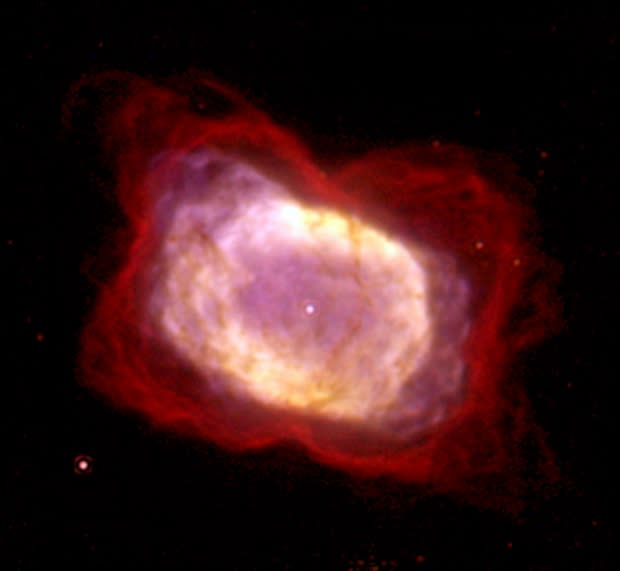Astrophysicists find elusive molecule that 'kick-started' the universe
They knew it had to exist, but they just couldn't find evidence of it. Now, after decades of searching, astrophysicists have found verification of the first molecule that formed minutes after the Big Bang.
The helium hydride ion (HeH+) the scientists detected wasn't the original one created just after the Big Bang, but it has the same molecular structure — helium combined with hydrogen — they theorized formed at the time.
"For the first time, we've detected the same type of molecule in a nearby nebula," said David Neufeld, co-author of the study in the journal Nature, who's a professor and astrophysicist at Johns Hopkins University in Baltimore.
"And it's exciting, because it's the first time it's ever been seen in space."
The elusive molecule had been reproduced in a lab in 1925, but astronomers had a tough time finding it naturally occurring in space. They'd been searching since the theory emerged in the 1970s.
They finally found it in NGC 7027, a planetary nebula that lies 3,000 light-years from Earth in the constellation Cygnus. It's only 600 years old, but has some of the best conditions where HeH+ might be found.
While some stars die in a spectacular explosion called a supernova, others shed their shell of gas and end up becoming extremely small — about the size of a planet — as well as very dense. The cloud of gas around it is called a planetary nebula, and is lit by the diminished star at its centre. NGC 7027 is one of the brightest planetary nebulae in our night sky.
Detective work
The Big Bang occurred roughly 13.8 billion years ago, when a single point that was extremely dense and hot rapidly inflated. This is when space and time began.
Temperatures cooled and the first atoms formed: helium, hydrogen and lithium. These elements existed separately, but scientists knew that, in order to create the elements we see today, there had to be a bonding of elements. They theorized that the first would be a joining of helium and hydrogen. But they couldn't find any trace of this anywhere in space.
Scientists knew they had to look for it somewhere where conditions mimicked the early universe. One of the best candidates was NGC 7027.
How the helium hydride ion was found:
Looking for HeH+ is difficult: it must be done using extremely sensitive equipment and through as little atmosphere as possible, which means ground-based telescopes aren't ideal in the search.
Fortunately, NASA (in partnership with the German Aerospace Center) has a telescope up for the job: SOFIA, or the Stratospheric Observatory for Infrared Astronomy. The observatory is actually a 2.7-metre telescope on a Boeing 747SP aircraft. The plane is flown to an altitude of roughly 43,000 feet (about 13 kilometres), a door opens and the telescope is aimed at its target.
The international team used an instrument on SOFIA called the German Receiver for Astronomy at Terahertz Frequencies (GREAT). This new technology makes it possible to observe in extremely high frequencies that are not accessible from the ground due to absorption by water vapour.
The telescope was pointed at NGC 7027 for three days in May 2016 and, finally, the molecule was spotted.

It took so long to confirm, because the scientists wanted to conduct a thorough analysis to ensure they had indeed found it.
"We wanted not just to say, 'We've seen it,' but to have a theoretical model that would seek to explain it," said Neufeld.
Finding it helped to confirm that astrophysicists' understanding of the universe was correct. But it did have them worried for a bit.
"The driver for the investigation has been to confirm the chemistry in the early universe," said Rolf Gusten, co-author of the paper. "The fact that the molecule was not observed for three decades in the local universe caused some doubts that our understanding was not right."
'Kicked off the process'
The formation of HeH+ was the universe's first molecular bond, and paved the way for the creation of other molecules. When it reacted with a hydrogen atom, for example, it created H2, or molecular hydrogen — marking the beginning of the modern universe.
"It kick-started things. It was the first molecule." said Renée Hlozek, a cosmologist at the University of Toronto's Dunlap Institute for Astronomy and Astrophysics, who was not involved in the study.
"We often think of the first molecule as being molecular hydrogen, because we see a lot of that in the universe … but this is what kicked off the process."
"This is one step on the whole chain," Hlozek added. "You can think of chemistry in the early universe as a cascading Rube Goldberg machine, where you start with one thing and then you start to form the others."
The researchers plan to search for more HeH+, which could exist in the heart of our galaxy — getting us ever closer to understanding how we ended up here.
"It's the first step on a path of increasing complexity that ends up with very complicated things in the universe, like very complicated molecules, like DNA," said Neufeld.
"Not that this helium hydride led directly to DNA, but it's basically showing you that what started out as a very boring, smooth universe just containing atoms can end up with more complicated structures, molecules — and ultimately, as we know, life."


